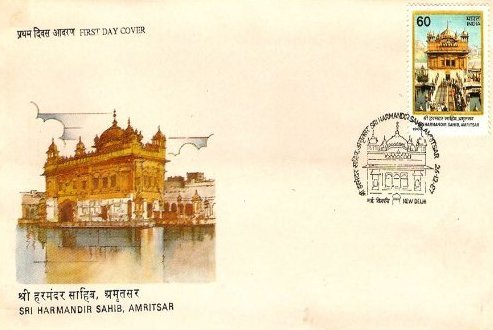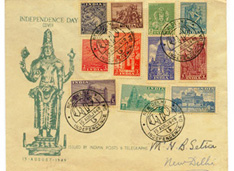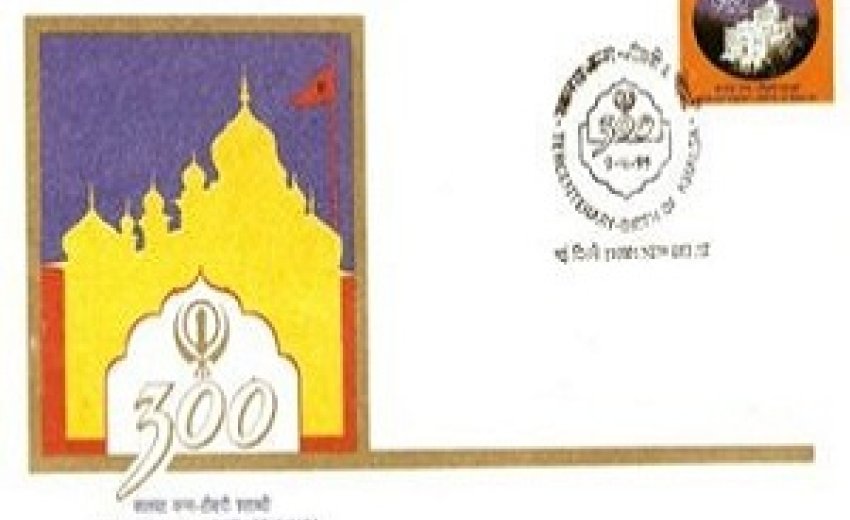
The Sikh religion evolved with the first Sikh Guru, Guru Nanak Dev in 1469 and got firmly established through the teachings of the subsequent ten Gurus. The places associated with the important events in the life of these ten Sikh Gurus are marked by Gurdwaras, erected in their memory. The word ‘Gurdwara’ means ‘doorway to the god’ and was first introduced by sixth Guru, Sri Har Gobind. It is the holy place of worship of Sikhs where the Guru Granth Sahib is kept and treated with utmost respect. These historical Gurdwaras have always been an integral part of Sikh history and its architecture. With a distinguished design for its many curves and straight lines and due to its progressive style, these evolved with new contemporary styles over a period of time. Buildings associated with Sikh architecture include fortresses, palaces, havelis and educational institutions as well.
 Over the decades, the Department of Posts and Telegraphs of India has issued several stamps of different denominations on these Gurdwaras and other popular buildings. In the prima-facie these sacred buildings play a dual role when depicted on the stamps, firstly representing the architectural splendour and secondly as an embodiment of a particular Sikh Guru or any important event associated with them. The latter are generally issued to mark some very special occasions of Sikh history.
Over the decades, the Department of Posts and Telegraphs of India has issued several stamps of different denominations on these Gurdwaras and other popular buildings. In the prima-facie these sacred buildings play a dual role when depicted on the stamps, firstly representing the architectural splendour and secondly as an embodiment of a particular Sikh Guru or any important event associated with them. The latter are generally issued to mark some very special occasions of Sikh history.
 The first Sikh stamp was issued in 1935 by the British Indian Government during the Silver Jubilee of King George V that represented the architectural marvel of Sri Harmandir Sahib. This 3 ½ Anna stamp was released along with a pictorial set of five other stamps depicting buildings like the Gateway of India, Victoria Memorial, Rameshwaram Temple, Jain Temple, Mandalay Pagoda and Taj Mahal from different parts of the country. The stamp depicts a black and white picture of the Gurdwara incased within a dull ultramarine border. King George V of England is shown on the right side. The style and layout is quite unique and its horizontal design makes it look almost like a paper currency note.
The first Sikh stamp was issued in 1935 by the British Indian Government during the Silver Jubilee of King George V that represented the architectural marvel of Sri Harmandir Sahib. This 3 ½ Anna stamp was released along with a pictorial set of five other stamps depicting buildings like the Gateway of India, Victoria Memorial, Rameshwaram Temple, Jain Temple, Mandalay Pagoda and Taj Mahal from different parts of the country. The stamp depicts a black and white picture of the Gurdwara incased within a dull ultramarine border. King George V of England is shown on the right side. The style and layout is quite unique and its horizontal design makes it look almost like a paper currency note.
In 1949, the newly formed Republic of India, issued a set of stamps on 15 August through its Postal Department to celebrate its Independence Day. It covered subjects on the sculptures and architectural edifices of various dynasties from different parts of the country. This group also had the first post-independence Sikh stamp depicting the edifice of Harmandir Sahib in monochromatic dull blue color. On the bottom left, the price 12 Anna is shown in English and on the bottom right the price is also shown in the ‘rajbhasha’ Hindi, the national language of the newly formed nation, representing its own identity among the various countries in the world. The First Day Cover, almost square in shape, shows a bronze statue of Hindu deity, Lord Vishnu from the Chola period.
To represent the sentiments of the people of different religions in a multicultural nation, the Postal Department started releasing stamps to mark the special religious occasions of national importance. Another change was the word ‘India Postage’ depicted in these earlier stamps was replaced by the words, ‘India’ and ‘Bharat’ (in Hindi) and this representation is followed till date.
 In 1969, the Department of Posts and Telegraphs marked the 500th Birth Anniversary of Guru Nanak by issuing a special stamp of 20 Paisa denomination. Guru Nanak, the first Sikh Guru traveled from place to place on foot to spread the message of love and universal brotherhood through his hymns. He devoted most of his time in meditation and inspired people to give up rituals and superstitions. The stamp shows Nankana Sahib (earlier known as Talwandi) the birth place of Guru Nanak, now in Western Pakistan in a monochromatic slate violet color. The First Day Cover shows Gurdwara Ber Sahib which stands at a place where Guru Nanak planted a Ber tree after getting enlightenment in the river Bein.
In 1969, the Department of Posts and Telegraphs marked the 500th Birth Anniversary of Guru Nanak by issuing a special stamp of 20 Paisa denomination. Guru Nanak, the first Sikh Guru traveled from place to place on foot to spread the message of love and universal brotherhood through his hymns. He devoted most of his time in meditation and inspired people to give up rituals and superstitions. The stamp shows Nankana Sahib (earlier known as Talwandi) the birth place of Guru Nanak, now in Western Pakistan in a monochromatic slate violet color. The First Day Cover shows Gurdwara Ber Sahib which stands at a place where Guru Nanak planted a Ber tree after getting enlightenment in the river Bein.
 Over the past innumerable years, langar (free food for all) has been served in the Gurdwaras and religious ceremonies and holds a great importance in Sikhism. It was given impetus by the third master, Guru Amar Das who tried to bridge the gap between the rich and poor by making them share food from a common kitchen at the same place. Even Emperor Akbar, who once visited Guru Amar Das at Goindwal, followed the Guru’s orders. This incident is beautifully captured in a painting represented on the First Day Cover issued in 1979 by the Postal Department on the 500th Birth Anniversary of the Guru along with a special stamp of 30 paisa. The Emperor seated in the centre, partaking meal with the common people can be easily noticed through his royal garments. Above is written in Punjabi- ‘philae pangat pachee sangat’ which means ‘Thou shalt be admitted into the Guru’s presence only after a meal in the langar’. The stamp shows Gurdwara Baoli Sahib bathed in sky blue colour with highlights of yellow and gold. Here at Goindwal, the permanent seat of Gurus residence was a baoli, a well with 84 steps dug which has now become an important point of pilgrim interest.
Over the past innumerable years, langar (free food for all) has been served in the Gurdwaras and religious ceremonies and holds a great importance in Sikhism. It was given impetus by the third master, Guru Amar Das who tried to bridge the gap between the rich and poor by making them share food from a common kitchen at the same place. Even Emperor Akbar, who once visited Guru Amar Das at Goindwal, followed the Guru’s orders. This incident is beautifully captured in a painting represented on the First Day Cover issued in 1979 by the Postal Department on the 500th Birth Anniversary of the Guru along with a special stamp of 30 paisa. The Emperor seated in the centre, partaking meal with the common people can be easily noticed through his royal garments. Above is written in Punjabi- ‘philae pangat pachee sangat’ which means ‘Thou shalt be admitted into the Guru’s presence only after a meal in the langar’. The stamp shows Gurdwara Baoli Sahib bathed in sky blue colour with highlights of yellow and gold. Here at Goindwal, the permanent seat of Gurus residence was a baoli, a well with 84 steps dug which has now become an important point of pilgrim interest.
 The architectural edifice of Harmandir Sahib which appeared on stamps both in the pre and post independence period celebrated its 400th Anniversary in 1988. Its foundation was laid by Hazrat Mian Mir, a Sufi Muslim saint of Lahore in 1588 under the supervision of fifth Sikh Guru Arjan Dev. On this occasion the Department of Posts issued a special stamp in the denomination of 60 Paisa showing the temple with the causeway. The First Day Cover shows a colored sketch of its side view with its reflection in the water of the sacred tank. The sacred scripture of the Sikhs, the Guru Granth Sahib, was first installed here and it came to be known as the Golden Temple when its upper part was decorated with richly embossed gold sheets during the period of Maharaja Ranjit Singh in 1803. The cancellation shows the line drawing of the same.
The architectural edifice of Harmandir Sahib which appeared on stamps both in the pre and post independence period celebrated its 400th Anniversary in 1988. Its foundation was laid by Hazrat Mian Mir, a Sufi Muslim saint of Lahore in 1588 under the supervision of fifth Sikh Guru Arjan Dev. On this occasion the Department of Posts issued a special stamp in the denomination of 60 Paisa showing the temple with the causeway. The First Day Cover shows a colored sketch of its side view with its reflection in the water of the sacred tank. The sacred scripture of the Sikhs, the Guru Granth Sahib, was first installed here and it came to be known as the Golden Temple when its upper part was decorated with richly embossed gold sheets during the period of Maharaja Ranjit Singh in 1803. The cancellation shows the line drawing of the same.
 Guru Teg Bahadur, the youngest son of the sixth Guru Hargobind assumed apostolic office as the ninth Guru and is remembered as the symbol of self sacrifice and courage. He urged people not to bow down to Emperor Aurangzeb’s policy of religious persecution and refused to embrace Islam. The Mughal emperor immediately arrested him along with his devotees and started torturing them to death that was inhuman, but none of his efforts could shake Guru’s faith and determination. On November 11, 1675 Guru Teg Bahadur was beheaded publically in Chandni Chowk, Delhi. On the tercentenary of the martyrdom of Guru Teg Bahadur in 1975, the Posts and Telegraphs Department issued a special stamp depicting Gurdwara Sisganj in Chandni Chowk, where his martyrdom took place. The holy shrine is depicted within an oval frame in bright orange colour. The First Day Cover shows Gurdwara Rakabganj where the headless body of the Master was cremated after his execution.
Guru Teg Bahadur, the youngest son of the sixth Guru Hargobind assumed apostolic office as the ninth Guru and is remembered as the symbol of self sacrifice and courage. He urged people not to bow down to Emperor Aurangzeb’s policy of religious persecution and refused to embrace Islam. The Mughal emperor immediately arrested him along with his devotees and started torturing them to death that was inhuman, but none of his efforts could shake Guru’s faith and determination. On November 11, 1675 Guru Teg Bahadur was beheaded publically in Chandni Chowk, Delhi. On the tercentenary of the martyrdom of Guru Teg Bahadur in 1975, the Posts and Telegraphs Department issued a special stamp depicting Gurdwara Sisganj in Chandni Chowk, where his martyrdom took place. The holy shrine is depicted within an oval frame in bright orange colour. The First Day Cover shows Gurdwara Rakabganj where the headless body of the Master was cremated after his execution.
 Guru Gobind Singh, born Gobind Rai succeeded his father Guru Teg Bahadur as the tenth guru of the Sikhs and assumed the apostolic office at the young age of nine. He followed in the footsteps of his father, and declared complete retaliation against the tyranny and oppression of Mughal Emperor Aurangzeb. He had four sons who joined him in the struggle for humanity and laid down their lives. Two of his elder sons died valiently fighting the Mughal army at Chamkaur while the other younger two were captured by the Nawab of Sirhind and executed. On the occasion of the 300th Birth Anniversary of the tenth master, Guru Gobind Singh, the Postal Department of India issued a special stamp in 1967 in the denomination of 15 Paisa. It shows Takhat Sri Patna Sahib in bluish violet tones. The First Day Cover shows the same picture in a slightly larger scale.
Guru Gobind Singh, born Gobind Rai succeeded his father Guru Teg Bahadur as the tenth guru of the Sikhs and assumed the apostolic office at the young age of nine. He followed in the footsteps of his father, and declared complete retaliation against the tyranny and oppression of Mughal Emperor Aurangzeb. He had four sons who joined him in the struggle for humanity and laid down their lives. Two of his elder sons died valiently fighting the Mughal army at Chamkaur while the other younger two were captured by the Nawab of Sirhind and executed. On the occasion of the 300th Birth Anniversary of the tenth master, Guru Gobind Singh, the Postal Department of India issued a special stamp in 1967 in the denomination of 15 Paisa. It shows Takhat Sri Patna Sahib in bluish violet tones. The First Day Cover shows the same picture in a slightly larger scale.
 Guru Gobind Singh played an extremely crucial role in modeling the Sikh religion by giving it a unique identity with the formation of the Khalsa fraternity. After the martyrdom of his father, he vowed to create such a Panth (Sect) which would challenge the tyrants and oppressors and restore justice, equality and peace for the whole of mankind. On Baisakhi day in 1699, the Guru summoned his followers from all over India for a congregation at Fort Keshgarh in Anandpur in Punjab where he demanded five heads as a sacrifice for the religion. Five of his followers volunteered one by one out of which four belonged to the suppressed classes. He called them ‘Panj Peyaras’, meaning the five beloved ones and gave them a surname of ‘Singh’, creating a new classless society called the Khalsa. To commemorate the tercentenary of the Khalsa Panth in 1999, the Department of Posts issued a special stamp depicting the holy shrine at Anandpur Sahib. The milky white architecture of the Gurdwara incased within an oval frame in saffron color stands out against a deep blue background. The First Day Cover shows the temple in contours of primary colors.
Guru Gobind Singh played an extremely crucial role in modeling the Sikh religion by giving it a unique identity with the formation of the Khalsa fraternity. After the martyrdom of his father, he vowed to create such a Panth (Sect) which would challenge the tyrants and oppressors and restore justice, equality and peace for the whole of mankind. On Baisakhi day in 1699, the Guru summoned his followers from all over India for a congregation at Fort Keshgarh in Anandpur in Punjab where he demanded five heads as a sacrifice for the religion. Five of his followers volunteered one by one out of which four belonged to the suppressed classes. He called them ‘Panj Peyaras’, meaning the five beloved ones and gave them a surname of ‘Singh’, creating a new classless society called the Khalsa. To commemorate the tercentenary of the Khalsa Panth in 1999, the Department of Posts issued a special stamp depicting the holy shrine at Anandpur Sahib. The milky white architecture of the Gurdwara incased within an oval frame in saffron color stands out against a deep blue background. The First Day Cover shows the temple in contours of primary colors.
 From the stamps released by the Department of Posts and Telegraphs on Sikh architecture till date only one shows a famous educational institution, depicting the Mohindra College at Patiala. Presently under Punjabi University it was created by Maharaja Mohinder Singh in the late 19th C. Its foundation was laid by the then Viceroy of India, in 1875 and inaugurated in 1884. Besides its architectural grandeur, it was the only institution stretching from Lahore to Delhi, attracting students from far and wide and occupied a place of eminence in the educational landscape of the country. To commemorate this prestigious institute the Department of Posts issued a special stamp in 1988. The stamp shows the photograph of the magnificent building in monochromatic pink. The First Day Cover shows the same picture in full colors.
From the stamps released by the Department of Posts and Telegraphs on Sikh architecture till date only one shows a famous educational institution, depicting the Mohindra College at Patiala. Presently under Punjabi University it was created by Maharaja Mohinder Singh in the late 19th C. Its foundation was laid by the then Viceroy of India, in 1875 and inaugurated in 1884. Besides its architectural grandeur, it was the only institution stretching from Lahore to Delhi, attracting students from far and wide and occupied a place of eminence in the educational landscape of the country. To commemorate this prestigious institute the Department of Posts issued a special stamp in 1988. The stamp shows the photograph of the magnificent building in monochromatic pink. The First Day Cover shows the same picture in full colors.
These stamps released over the years give a silent message by paying homage to these places of veneration. They not only make a little pilgrimage tour in themselves but reflect the same peace and solace which one gets by visiting them. They truly represent important memoirs and make ones collection truly remarkable and noteworthy.

